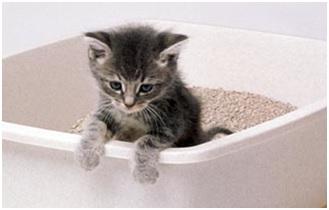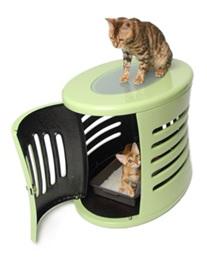Adopting a cat or kitten can be one of the most fulfilling and happy experiences life has to offer. They are soft, funny, playful, cuddly and loyal to the ones they love. But sometimes some minor mishaps can happen. Sometimes a cat cannot or will not use the litter box properly. While this may be a concern to the owner, it is that it's usually a fixable problem. Most cats are naturally tidy animals with a strong instinct to bury their waste. This makes litter box training simple. Learn five essential litter box training tips for cats.

Choosing the right litter box can mean the difference between immediate litter box training success and life-long cat box battles. The type of litter box you choose can be really important. Here are a few points to keep in mind when making your selection:
Another important consideration for a litter box is that it be large enough for your cat to turn around and give the litter a few good kicks. According to the Merck/Merial Manual for Pet Health, cats have a natural tendency to cover their waste, so be sure to buy a box that allows them to do so.
Many owners buy boxes with doors on them to minimize the odours. If your cat is not used to this type of box, then it may have difficulty (or even fear) adjusting to the door concept. Luckily, most litter boxes that come with doors are built so that the doors are easily removed so that you can transition to the closed door version slowly.
A general rule of thumb for litter boxes is that the number of litter boxes in your house should equal the number of cats you have, plus one. In other words, if you have one cat, there should be two litter boxes in your home. Two cats need three boxes, etc. This is especially important for a cat that is having trouble using a litter box.
Another significant thing to consider is where the litter box is located. You should place your cat's box in an area of the house that is both quiet and easily accessible. Cats are skittish and sensitive animals and they won't go in a box that's in a high traffic or chaotic spot. One exception is for a formerly outdoor/newly indoor animal. In this case, it may be best to place a litter box near the door if that's where your nature-loving feline is lingering.
Make sure that it is not near its food or water either as this will affect both their use of the litter box and their eating habits.

Also, it is ideal if it is against a wall or in a corner so that the cat does not have to fear ambush from another cat. Once that happens, then it will be difficult to get your cat to use the litter box properly again until the trauma subsides. You may want to avoid areas where there are sudden loud noises such as the water heater or air conditioner will turn on automatically until your cat becomes acclimated to the environment and the sudden sounds become the norm.
Learning to use a litter box is pretty much instinctive for cats. Still, there are some helpful tips for making the process goes as smoothly as possible. The first is to show your new pet the litter box as soon as you bring him into your home for the first time. Don't worry if he hides at first -- this is normal. Placing the litter box wherever your cat feels comfortable and then gradually moving it to your preferred location.

You may also want to place your pet in the litter box after naps, meals, play sessions, and whenever you think he appears inclined to "go." Keep this up during the first few days of your relationship with your new pet, and you should achieve litter box success in no time.
There are a few dos and don'ts that are vital to litter box success. Probably the most important is that you keep the box clean. Scoop the poop from the box at least once a day and clean it with soap and water once a week. Cats are finicky creatures, and many will turn up their noses at a filthy litter box.
On the other hand, don't try to cover your cat's scent with perfumed litter. Many cats will be deterred by the perfume's odour. A cat also needs to be able to locate the litter box by his own scent. If he can't smell it, chances are he won't find it.


The last tip is to find a litter your cat seems to like and stick with it. Test out a new brand and watch your cat's reaction. If he paws at it a few times and then leaps out of the box with a disgusted look on his face, chances are he doesn't like it. Finding one he does like -- as exampled by his willingness to use it -- may require trial and error, but your efforts will undoubtedly pay off in the long run. If you are bringing a cat home for the first time, try to use the same litter that the cat used in his previous home/shelter and slowly transition to another litter if you wish. If you have more than one litter box, change only one litter to the new one and keep at least one other one with the old litter. Check to make sure that the cat(s) are using the new litter or both before you slowly continue the transition.
The most important thing to keep in mind when training a cat to use the litter box is not to punish or scold him while he is in the litter box. This will definitely create a negative association with the box itself. If your pet makes mistakes, pick him up and place him in the litter box. He'll make the connection soon enough. It also helps to praise him or give him a treat when he uses the box successfully.

The vast majority of cats are naturally attracted to the litter box to complete his “business”. If your cat is not doing so, it usually means that they are avoiding it because of litter preference, litter box dirtiness or some sort of stress in their environment. You may want to take him to the vet to ensure that he does not have a urinary tract problem or other health issue that may be the cause. Whatever the case, litter box problems are usually fixable with a bit of time, attention and consistency.